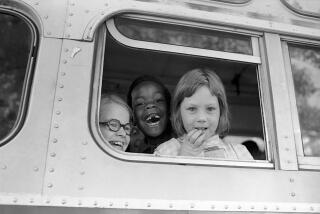Modern Education Can Learn From Them, Teacher Says : One-Room Schools Live On as Symbol
- Share via
TOLEDO, Ohio — Andy Gulliford studies one-room schools, the kind he saw abandoned near his home on the high plains of Colorado.
The 30-year-old instructor at Bowling Green State University has spent six years teaching in conventional schools and seven years researching, writing about and photographing one-room schools.
About 850 public schools in America still are run on the one-room principle--several grades learning together under the same teacher. No one knows how many one-room schools existed in the late 1800s, but Gulliford estimates there were close to 10,000 in Ohio alone, scattered across the state three or four miles apart.
Gulliford knows of 28 such buildings remaining in Ohio. Two one-room public schools operate on the Lake Erie islands; the rest are museums, community buildings or homes or have been converted into storage bins for grain and farm tools.
Those figures, garnered from historical societies, community documents and interviews with persons who attended rural schools, do not reflect the number of one-room schools run privately, often by churches, Gulliford says. He contends that one-room schools still play a big part in American education, but for all the wrong reasons.
“One-room schools continue to function as an American icon,” he says. “They’re a symbol. To some people, they’re a symbol of a cozy kind of education.”
In reality, most one-room schools were anything but cozy: They had poor heating, were isolated, used out-of-date texts and their teachers often had less than a high school education. And the nostalgia people feel toward them may keep their real value from being acknowledged, Gulliford says.
“What I’m saying is that that time in American education has passed. But the idea of looking at what did work in the one-room schools and applying it to today’s schools is good.”
The things that worked, he believes, were community involvement in the schools, having older students teach younger students and the learning by repetition that resulted from young students’ hearing their elders’ more advanced lessons.
“Children often learned the same thing eight times,” Gulliford says.
Children in one-room schools always got a part, and maybe two or three, in the school play, and their parents visited the school fairly frequently. Gulliford believes that kind of involvement is lacking today.
“Not only school was held there, but dances were held there, political rallies were held there, town meetings were held there. Every single thing that has changed in America in the 20th Century was organized in the schools,” Gulliford said. He cited Prohibition, women’s suffrage and agriculture extention groups as examples of topics that first were discussed in the politically neutral setting of the school.
That involvement kept the schools and students from becoming isolated from the community and helped parents understand their children’s school life, Gulliford says.
Many educators scoff at the idea that one-room schools are anything other than part of the past. But some schools, especially private ones, are beginning to incorporate old-fashioned education methods in modern facilities.
School systems are economizing by renting their buildings for public purposes, from aerobic exercise classes to congressional hearings, breaking down barriers between the school and the community.
Several schools around the nation train older children to help those in lower grades and are trying to offer more individual attention to students, harking back to the days when pupils went to the blackboard one by one to review their lessons with the teacher.
Gulliford says that educators should strive to preserve the structures of one-room schools as well as what went on inside them. In his study, he looked at the historical and social significance of rural schools, which he says were the common thread shared by rural residents throughout the country.
More to Read
Sign up for Essential California
The most important California stories and recommendations in your inbox every morning.
You may occasionally receive promotional content from the Los Angeles Times.











